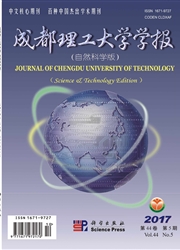

 中文摘要:
中文摘要:
2013年4月20日四川省芦山7级地震是"5.12"汶川地震后龙门山断裂带又一次强烈地震,初步统计地震触发了1800余处具有危害性的地质灾害点,比地震前增加了14%。地质灾害高发区位于Ⅷ、Ⅸ烈度区的龙门-宝盛-太平-双石、大溪-灵关-中坝-穆坪等区域。地质灾害主要类型为浅层滑坡与崩塌、落石,以崩塌体最为显著,失稳模式为震动-拉裂-滑移、震动-拉裂-错落、震动-偏心滚落3种。地震地质灾害除受控于强震触发作用,陡峻的地形地貌、地形与高程放大效应特征突出,同时软弱的岩性、强风化卸荷作用也是地质灾害产生的物质基础。地震崩塌、滚石的危险区范围Dmax=(0.7~1.3)Hmax,滚石的运动距离dmax≈1.1404 Hmax+6.42,与汶川地震崩塌的研究成果是吻合的。
 英文摘要:
英文摘要:
Abstract. The "4 · 20" Lushan earthquake is another strong earthquake occurred in the Longmenshan fault zone after the "5· 12" Wenehuan earthquake. The Lushan earthquake triggered more than 1800 harmful geological hazards, which increased by 14 percent than before the earthquake. The areas where geological hazards occur high frequently are located in that with ~ and IX grade intensity, including Longmen-Baosheng-Taiping-Shuangshi and Daxi-Lingguan-Zhongba-Muping. The main types of geological hazards include shallow landslides and collapses, rockfall, particularly the collapsed bodies. Their failure mode is vibration-fracturing-sliding, vibration-fracturing-scattered and vibration-eccentric roiling. Besides the earthquake triggering effect the earthquake geological hazards are controlled by the prominent characteristics of steep topography, terrain and elevation amplification effect. And the weak lithology and the strongly weathered unloading rock mass are the material basis of geological hazards. According to the field survey, many geological hazards are directly caused by the earthquake casualties. The range of the earthquake collapse and rockfall danger zone is Dmax= (0.7 -1.3)Hmax and the rockfall movement distance is dmax≈1. 1404Hmax+6.42. These are consistent with the research results of the Wenchuan earthquake's collapse.
 同期刊论文项目
同期刊论文项目
 同项目期刊论文
同项目期刊论文
 期刊信息
期刊信息
